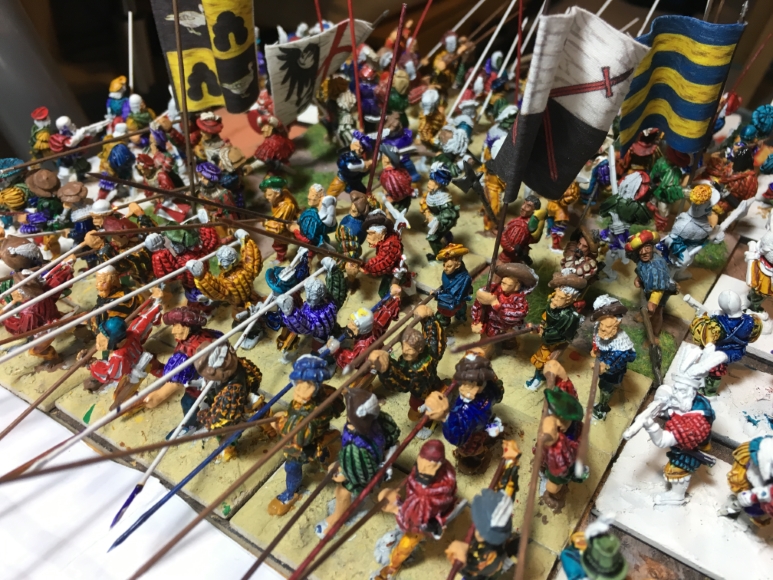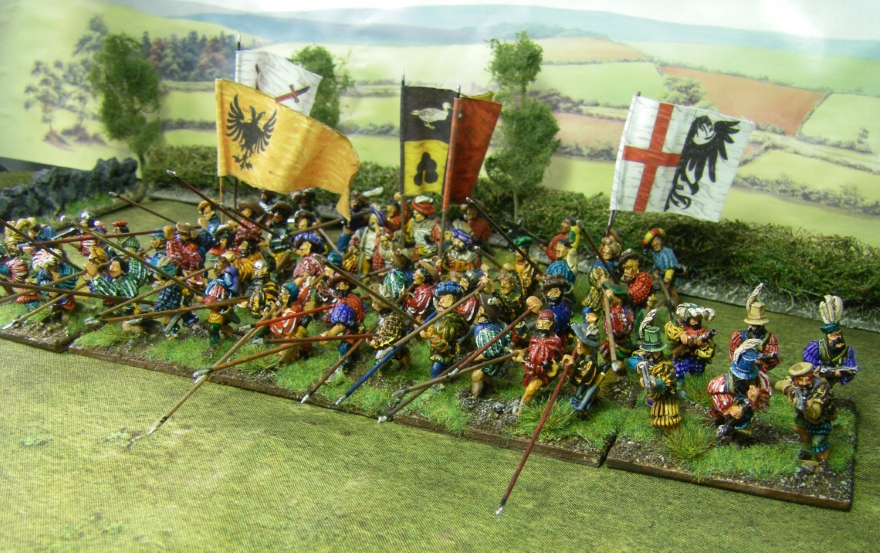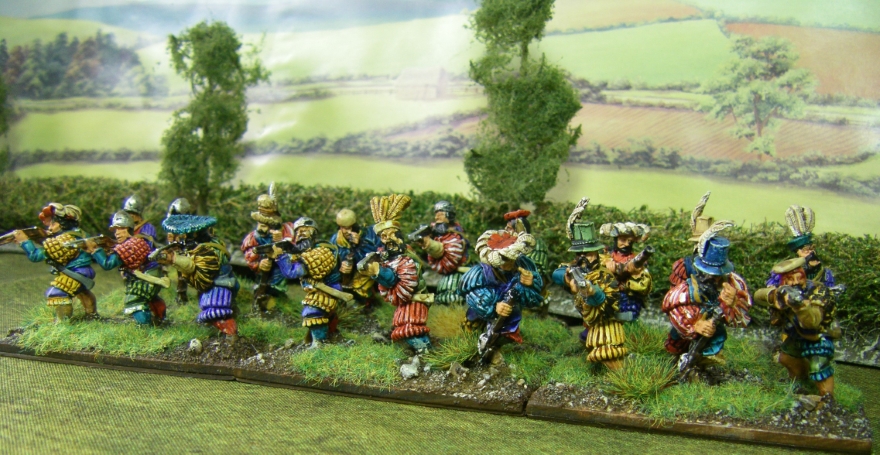Photos of 28mm Landsnechts & Swiss for FoGR
(or, how I learned to find the truth in the Contrast paint hype)
You know those painting projects that seem never to die? They just drag on and on, staring at you and each time you start trying to move them along the sheer quantity of painting ends up crushing your will to continue?
(There is lot's more of this stuff on my Links Page)
Well, for me that was a big winged-Keil of Landsnechts in 28mm, bought for FoGR in a series of bring and buy used-figure bags - and then supplemented by a pack of Old Glory arquebusiers.
With FoGR slowing down and other scales and systems taking more of my time I had even made a couple of half-hearted attempts to sell them as a part-painted project - but no-one really wants to buy something thats half-painted, do they?
Archduke Maximilian I von Habsburg, who inherited Burgundy in 1477 by marrying Mary of Burgundy, began raising the first Landsknecht units in 1486 amassing 6,000 - 8,000 mercenaries. One of these units he gave to Eitel Friedrich II, Count of Hohenzollern, who trained them with Swiss instructors in Bruges in 1487 to become the "Black Guard" : the first Landsknechte. (Wikipedia)
The large and motley collection of different manufacturers had been based, undercoated and half-done ... but, whilst at an event in Bristol I got chatting to the man from BIG about the hype around the new Games Workshop contrast paints.. and suddenly realised that the Landsnecht project might be a good way to test these supposedly magic high speed paints, on a colourful army that otherwise simply may never end up being finished.
In 1488, Maximilian organized the Swabian League, creating an army of 12,000 infantry and 1,200 cavalry to deter Bavaria and Bohemia. This is considered to be the first Landsknecht army to be raised in Germany. Maximilian raised a strong army for the Austrian-Hungarian War of 1490, and succeeded in driving the Hungarians out of the Austria. The Landsknechte in his army refused to serve after sacking Stuhlweissenburg (in Hungary), citing lack of pay and stopping Maximilian's advance on Budapest. To prevent a repeat of Stuhlweissenburg, Maximilian now sought to homogenize the Landsknechte into a fully professional, and mostly Germanic military force (Wikipedia)
So, with just 4 pots of contrast paint, and a couple of Windsor & Newton colourful inks I just started to slap paint all over the 2 Kiels at quite a rate of knots
The GW paints were Blood Angel Red, Akhelian Green (which is kinda blue), Creed Cammo and Nazdreg Yellow
On these arquebusiers you can see the Nazdreg Yellow on the chap on the left, and the trousers of the 3rd chap from the right (front rank). These are all Old Glory 25mm figures
In the 1490s, the well-trained Landsknechte managed to defeat significantly greater Frisian armies. Paul Dolnstein wrote of the siege of Alvsborg Fortress in July 1502, fighting for the King of Denmark: "We were 1800 Germans, and we were attacked by 15000 Swedish farmers ... we struck most of them dead." In 1521, the Spaniards recruited German infantrymen to defend their country against the French because, as they stated "our infantry does not perform as well in its native country as abroad". At the Battle of Bicocca and the Battle of Marignano (1515), the Landsknecht performed well, defeating the famed Swiss (Wikipedia)
The trousers of the guy right at the front are the Akhemian Green ... which is turquoise, not green
Modern Landsnechts
Here they are also pretending to be Swiss with some downloaded flags
The Imperial Landsknechte were instrumental in many of the Emperor's victories, including the decisive Battle of Pavia in 1525. The same year, they also managed to defeat the peasants' revolt in the Empire. At their peak in the early 16th century, the Landsknechte were considered as formidable soldiers who were often brave and loyal. However, these qualities may have declined afterward. From the 1560s on, the reputation of the Landsknechte steadily decreased. (Wikipedia)
I gave some of the pikes a colour instead of painting them just in brown all to make them even more colourful
In the French Wars of Religion and the Eighty Years War, their bravery and discipline came under criticism, and the Spanish elements of the army of Flanders regularly deprecated the battlefield usefulness of the Landsknechte, somewhat unfairly. Their status also suffered from the rising reputation of the dreaded Spanish tercios which, however, were far less abundant and more expensive to train. It should also be noted that when serving in southern Europe, Landsknechte were still considered as elite troops. In the army of the Dutch rebels, many German mercenaries were hired but were forced to give up some Landsknecht traditions in order to increase their discipline in River Crossing and their Naval fighting abilities (Wikipedia)
The 5th front rank pikeman from the laft had purple sleeves - this is Windsor & Newton Violet ink over a white undercoat, which has a similar effect to the Contrast paints by pouring into the crevasses of the figures casting.
The Imperial Landsknechte They are attested as deployed in the armies of Kings John III of Navarre and successor Henry II of Navarre during their campaigns to reconquer Navarre (1512 - 1524). In the same context, they are also found fighting on Charles V's side (battle for Hondarribia, 1521 - 1524) where they performed strongly. They also served in high numbers in the Imperial army during the campaigns of Austria (1532), France (1542), Germanic Reformed League (1547) and in of all the Italian wars. (Wikipedia)
Once they were painted with the contrast colours I also added some rough and ready white stripes to the slashes on their sleeves. Doing this on the inked figures meant that they had to be double-varnished to lock the ink in place, as otherwise the ink just dissolves and bleeds into the additional layer of paint
The army of the Holy Roman Emperor defeated the French army in Italy, but funds were not available to pay the soldiers. The 34,000 Imperial troops mutinied and forced their commander, Charles III, Duke of Bourbon, to lead them towards Rome. The Sack of Rome in 1527 was executed by some 6,000 Spaniards under the Duke, 14,000 Landsknechte under Georg von Frundsberg, some Italian infantry and some cavalry. (Wikipedia)
Theses arquebusiers are mostly Contrast Paints - the yellow trousers of the guy on the left show the effect of the paint, but I actually found that one of the best things about it was that it flows / slops really easily and quickly onto the figures - so it's a nice effect, but it is also far, far quicker to slop onto the figures than painting with normal paints
Modern Landsnechts
This lot of arquebusiers are entirely done in the 4 contrast paints and the purple ink.
Experienced and well-equipped soldiers, receiving double a normal Landsknecht's pay and getting the title Doppelsoldner made up a quarter of each Fahnlein. 50 of these men were armed with a halberd or with a 66-inch (170 cm) two-handed sword called a Zweihander while another fifty were arquebusiers. (Wikipedia)
The Dopplesoldners are a very random and rough mix of different manufacturers
I also based them with sand, with woodstain and then a drybrush to finish.
Landsknecht formations consisted of men trained and armed with pikes, halberds, and swords. 300 men of a Fahnlein would be armed with a pike, though a Landsknecht's pike was generally shorter than a Swiss Pike at about 4.2 meters (14 ft). (Wikipedia)
The three guys bottom left were painted a while ago in proper paints. They aren't that much better but took much longer!
All Landsknechte, regardless of primary weapon, carried a short sword called a Katzbalger for close melee combat. By the end of the 16th century, however, the number of pikemen in a Fahnlein had diminished to around 200. (Wikipedia)
Redoubt's character figures drinking and gambling
Some of the guys have fallen asleep outside the privvy door.
Tactics were copied part and parcel from the Swiss. Landsknechte fought in a pike square they called the gevierte Ordnung forty to sixty men deep. Doppelsoldnern made up the formation's first two ranks. Then came the ensigns, and then the squares themselves. Pikemen, supported by halberdiers, formed the square while swordsmen made up their front and rear. The most experienced soldiers were located at the back of the formation and arquebusiers were placed on its flanks. In the attack, a band of soldiers called a forlorn hope preceded the pike square to break enemy pikes. (Wikipedia)
The Landsnechts were a pleasant bunch - I can't sadly remember where I got this guy (and the privvy) from though!
The Summary
In enabling me to get this significant lump of figures (120-odd!) done quickly the GW contrast paints certainly lived up to their reputation for speed-painting. Perhaps they aren't as good as using real paints and a lot of time, but to 'splash and dash' to get stuff on table in an acceptable manner they did the job
The real benefit was the speed of application - far quicker than normal paint. I usually use an Army Painter varnish finish but these guys didn't really need it - indeed, with the pre-shaded way the Contrast paints work adding an Army Painter-style top layer may well have left they just a bit too dirty looking
Will they win any awards? No. Could I have painted them better given more time? Yes. Would I have painted them at all given how long it was taking to get them finished? Probably not. And, at the end of the day, that's the key advantage I see in these paints.
That's the end - so why not go back to the Links Page and browse through some more stuff








































